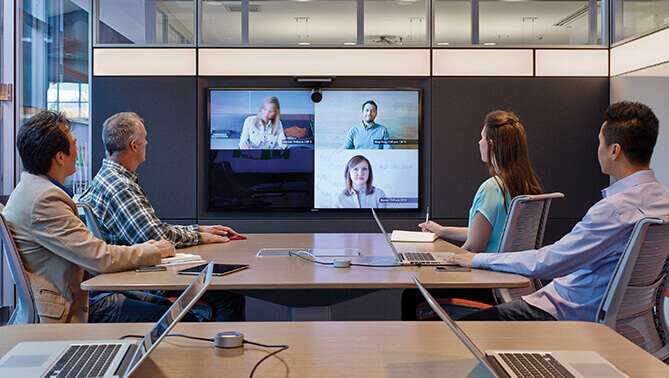The hybrid office environment has emerged as a viable work option during the pandemic.
What is a hybrid office? It’s a flexible work setting that blends in-person and remote workers.
Through 2020 and 2021, businesses gradually brought employees back to the office. However, many companies recognized during the pandemic’s outset that professionals don’t have to be physically present 40 hours per week to accomplish their goals.
Instead, many businesses created a hybrid work environment. There are two primary types of hybrid offices:
- Either/Or: Employees either work full time in the office or full time remotely. This approach allows businesses to maintain a physical presence in a community. Meanwhile, skilled professionals can maintain their employment if personal factors impact their ability to work in the office. These factors can include a spouse’s relocation, child care issues or medical conditions.
- Half and Half: Employees work specified days at the office and specified days at home. This approach allows companies to reduce their overhead costs for facility space while keeping employees socially distanced. Employees have some degree of work-life flexibility under this approach. It also allows employees to work remotely if they need to quarantine due to possible exposure.
According to a Salesforce survey, 72% of “knowledge workers” say they’ll make or maintain at least one major change to their work lives after the pandemic. These include changes to work hours, work locations or daily schedules. Mercer’s Coronavirus Business Impact Survey noted 87% of employers say they will embrace greater flexibility after the pandemic, including a hybrid work model. The Steelcase Global Return to Workplace Study found that 54% of businesses plan to run pilot programs to set workplace strategies.
To operate a successful hybrid workplace, businesses should focus on these three factors:
Tip 1: Workstations
For generations, the standard office featured one desk and one chair for every employee. That individual would have exclusive use of that space; it was his or hers to call their own. Employees would fill drawers and shelves with personal belongings, photos, paperwork and snacks.
In a hybrid setting, though, a portion of desks and chairs would be empty at any given time. That’s in addition to desks left vacant when employees are on vacation or sick. In today’s hot real estate market, every square foot of office space comes at a price. That means an empty desk is costing a company money. Inc. magazine notes as much as 40% of desk space is vacant at any given time with employees on vacation or sick leave, working at home or in meetings.
Instead, many businesses have turned to “hot-desking.” The term describes offices that feature desks or workstations with no assigned employees. Instead, employees simply sit down at an available workstation.
Hot-desking has become more feasible because of technology. Many records and files can be securely stored electronically, eliminating the need for shelves and cabinets to house documents. Hot-desking is popular for four additional reasons:
- It makes efficient use of spaces
- It keeps workstations free of personal clutter
- It allows employees to select a comfortable workspace
- It fosters collaboration with employees from other departments or teams/li>
As a leading provider of office furniture and design, OFDC Commercial Interiors provides solutions for businesses converting to hot-desking. A variety of pods, nooks, lounges and other office furniture are available online.
SHOP: Office products
Tip 2: Office Design
Open floorplans have been trendy since the early 2000s. The design concept helps foster collaboration, teamwork and creativity.
In an era of social distancing, though, shared or open spaces can foster the spread of viruses, germs and bacteria.
Employees do not necessarily need to be wall-in. OFDC’s design specialists can reconfigure spaces to keep employees safe. Employees’ workstations can be positioned back to back rather than facing each other, or desks can face walls rather than open spaces.
A once-maligned representation of the typical corporate office – the cubicle – is making a comeback. Cubicles offer an added layer of protection and give employees a sense of privacy without creating a closed-in environment.
OFDC also offers Rapid Response Screens and Harbor Screens, which are temporary barriers between desks. Some dividers are clear or opaque, thus allowing light to filter through.
SCHEDULE IT: Complimentary Consultation
Tip 3: Technology
Businesses must allow remote access to accommodate remote workers. Web-based or cloud-based programs allow for remote connectivity, but security protocols must be in place. Antivirus programs are a must.
With many client- or customer-facing meetings now virtual, it’s important to have a professional appearance on video calls. In the home office, consider moving a bookshelf or framed artwork into the background. Lighting also is important so employees radiate on camera. In the main office, the background can include “props” such as products, merchandise or company awards.
Remote workers also need a remote office. When the pandemic started, many employees quickly learned that the kitchen table or sofa could not double as a workstation. A proper home office includes a desk, chair and storage solutions, as well as good lighting.
LEARN MORE: 5 tips to create an office space you can love
Need help transitioning your office space to a hybrid work environment? Complete our online Complimentary Consultation form to learn more.


